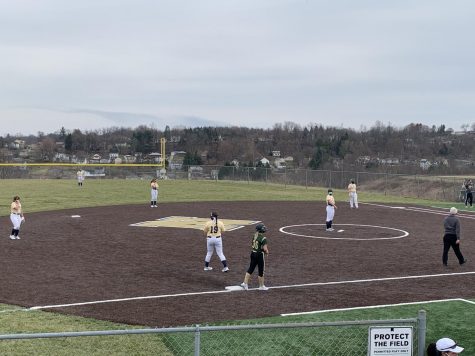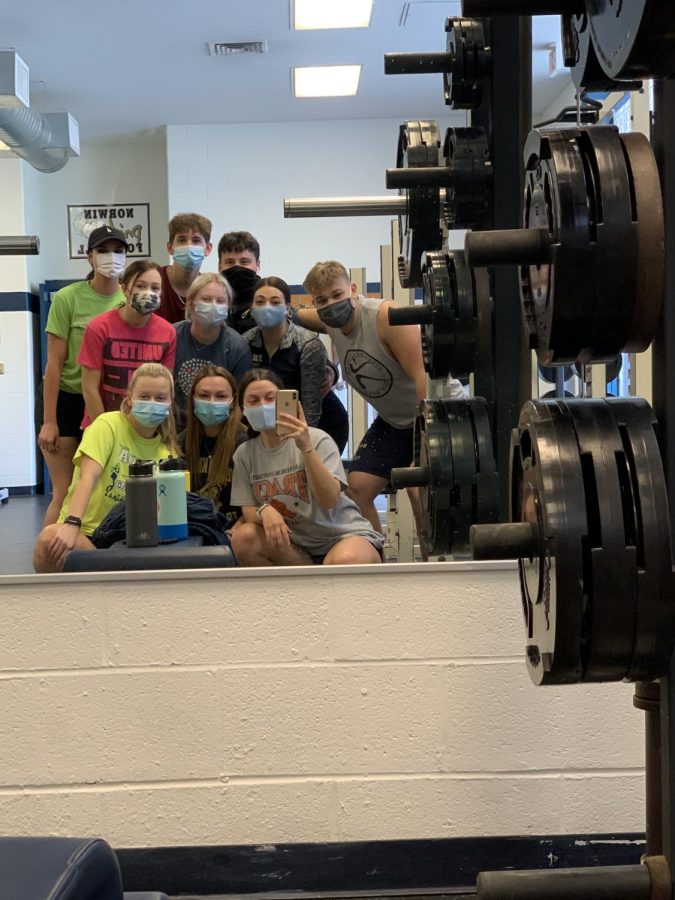Flowers blooming, spring sports changing
COVID-19 rules and regulations for spring sports
The throwers join for a photo before starting their lift.
March 17, 2021

As the start of spring sports begins, the new COVID-19 rules begin to develop and change each sport as a whole.
On March 3. the PIAA board met online and approved the “Return to Competition Guidelines.” There are new guidelines that apply to all spring sports such as: athletes can remove their masks while out as long as they are 6 feet apart, each sport can start competition on March 26. and each team must conduct a pre practice COVID-19 screening. Each of the following basic rules above were put into place by the Norwin School District and monitored under Athletic Director, Michael Burrell.
Although each sport must follow the same basic rules through the whole season, each sport has their own specific rules that must be followed.
The main focus of the PIAA board meeting was the issue of wearing masks. The board was struggling with when having to decide what athletes have to wear masks, what athletes don’t have to wear masks, and when masks are not required during a competition.
___________________________________________________________________________________
Here are the new COVID-19 rules and regulations for each spring sport:
BASEBALL & SOFTBALL:

In baseball, if the pitcher decides that he wants to wear a mask it must be a solid dark color. This rule was put in place so the pitcher is not distracting the batter at any time. In softball, if the pitcher chooses to wear a mask it cannot be a bright yellow color. It must be a solid color that won’t distract the batter from not being able to see the ball.
“If you are playing in the field while no one is around you, for example if you are in right field, no one is around you so you do not have to wear a mask,” said Burrell. “As for pitches they do not have to wear a mask. But while you are in the dugout and in the batter’s box near the umpire and catcher, you must be wearing a mask.”
Now that these rules have become clear and enforced to both the softball and baseball team, starting pitcher, senior Jacob Bazala explains how he plans to pitch this season.
“I personally do not plan to wear a mask while I am pitching,” said Bazala. “Not only could it distract the batter but it could distract me if it falls down or flys off.”
The PIAA also discussed allowing umpires to stand behind the pitcher and call balls and strikes. But they decided against this rule. Umpires are expected to wear a face covering while calling balls and strikes from behind the plate.
Both baseball and softball are allowed to use their own balls for each inning they play in the field. But this rule is not mandated in either sport.
“I don’t think the new rules will affect us during practice and games,” said Bazala. “But we have to be careful about following the mask rules so we can continue to have a season.”
___________________________________________________________________________________
TRACK & FIELD:
Each event has specific rules that must be followed by every athlete, coach and official. In the throwing events, shot put, javelin and discus, each athlete must retrieve their own implement and help their throw get measured.
“I am okay with getting my own shot put and discus after I complete my throw,” said senior thrower Brennan Hileman. “But the only issues with doing that is the risk of stepping out the front of the circle/runway and scratching your throw.”
The relays have also been given the option to wear disposable gloves during their relay. But if one athlete in the relay chooses to wear gloves, the rest of the athletes in the relay must wear them as well. Any race of 800 meters or longer is seen as a “moderate risk activity” to complete while wearing a mask. So those events require athletes to attempt to spread out throughout the race.
The main rule that the PIAA is most worried about, is the sharing of implements, starting blocks, and batons. If any of those pieces of equipment are shared at any time, athletes are expected to sanitize each piece of equipment before passing it on to the next athlete.
“I do not believe any of these new COVID-19 rules will affect the team as a whole,” said Hileman. “We have been pretty successful during practice. As long as we are still practicing and getting better while also building and developing a bond as a team, it will be just like any other season.”
___________________________________________________________________________________
LACROSSE:
The PIAA chose the rules for lacrosse based off the same rules they applied to football this fall. Since both boys and girls lacrosse, wear a helmet/faceguard and a mouthguard, neither team has to wear a mask while playing.
“The stick checks really don’t change anything other than we aren’t there when the refs check our sticks,” said senior Cory Johnson. “As for the masks, it’s very good to hear that we don’t have to wear a mask. Especially since during football season we didn’t have to either and you are closer in football than lacrosse anyway.”
The main rule for both boys and girls lacrosse is the process of each player’s stick being checked before the game. Rather than stacking the sticks in a pile, each athlete is expected to set the stick in front of them and step back to the bench while the officials check the sticks.

Along with the rules that lacrosse must follow, there are a few minor rules that the PIAA recommends following but are not mandated. There has been no changes to the draw (face off) at the beginning of the game or after goals. But PIAA officials recommend that goalies roll the ball back to the official after a goal is scored.
“I don’t think the new rules will affect the team,” said Johnson. “Being without a mask will help a lot with communication on the field and with avoiding any COVID-19 problems.”
___________________________________________________________________________________
TENNIS & VOLLEYBALL:
Both tennis and volleyball rules have not changed much since the fall. Tennis players are not forced to wear a mask while playing. But unlike the fall volleyball season, boys volleyball must wear a mask at all times while competing and practicing. The PIAA also notes that there has been no evidence that proves that COVID-19 can be transmitted through tennis balls or volleyballs. Although officials still recommend that you sanitize your hands before the game/match and refrain from touching your face.
___________________________________________________________________________________
These new COVID-19 rules and regulations may create an extremely different competition atmosphere for athletes. But the PIAA put these rules into effect to protect each athlete and their seasons.
“A large majority of credit for keeping our athletes safe and healthy goes to the coaches,” said Burrell. “They have followed all of our self and safety plans and all of our protocols to a tee. Without them enforcing that may have not had the past two seasons.”
Another large question that applies to all sports that the PIAA board had to visit was: what will be the spectator capacity for games and matches? After the PIAA released the guidelines, Governor Tom Wolf revisited his restrictions on fans attending games based on cases decreasing throughout the state.
“For both indoor and outdoor spring sports 15% of our ventunes capacity is allowed to be used,” said Burrell.
As the start of spring competition is approaching many athletes, and especially seniors, are prepared to follow any rules that are put into effect to protect their seasons.
“Some of these new rules are odd. But after losing my entire junior year, I am willing to do anything asked of me to be able to have my senior season,” said senior track athlete Brooke Alexander. “I still believe that each spring sport will continue to have successful practices and seasons.”



